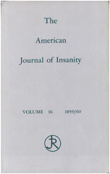A family study of obsessive-compulsive disorder
Abstract
OBJECTIVE: The goal of this study was to determine 1) whether obsessive- compulsive disorder is familial, 2) whether there is a familial relationship between obsessive-compulsive disorder and Gilles de la Tourette's syndrome and chronic tics, and 3) whether different familial types of obsessive-compulsive disorder exist. METHOD: In this family study, all available first-degree relatives of 100 probands with obsessive-compulsive disorder were interviewed directly with structured interviews, and best-estimate diagnoses were assigned. In addition to the 466 first-degree relatives of the probands, 113 comparison subjects who were first-degree relatives of 33 psychiatrically unaffected subjects were studied with the same interviews. RESULTS: The rates of obsessive-compulsive disorder and subthreshold obsessive-compulsive disorder were significantly greater among the relatives of the probands with obsessive-compulsive disorder (10.3% and 7.9%, respectively) than among the comparison subjects (1.9% and 2.0%, respectively). Furthermore, the rate of tics (Tourette's disorder and chronic tics) was also significantly greater among the relatives of the probands (4.6%) than among the comparison subjects (1.0%). The relatives of female probands with obsessive-compulsive disorder were more likely to have tics, and the relatives of probands with early onset were at higher risk for both obsessive-compulsive disorder and tics. CONCLUSIONS: Obsessive-compulsive disorder is a heterogeneous condition. Some cases are familial and related to tic disorders, some cases are familial and unrelated to tics, and in other cases there appears to be no family history of either obsessive-compulsive disorder or tics.
Access content
To read the fulltext, please use one of the options below to sign in or purchase access.- Personal login
- Institutional Login
- Sign in via OpenAthens
- Register for access
-
Please login/register if you wish to pair your device and check access availability.
Not a subscriber?
PsychiatryOnline subscription options offer access to the DSM-5 library, books, journals, CME, and patient resources. This all-in-one virtual library provides psychiatrists and mental health professionals with key resources for diagnosis, treatment, research, and professional development.
Need more help? PsychiatryOnline Customer Service may be reached by emailing [email protected] or by calling 800-368-5777 (in the U.S.) or 703-907-7322 (outside the U.S.).



